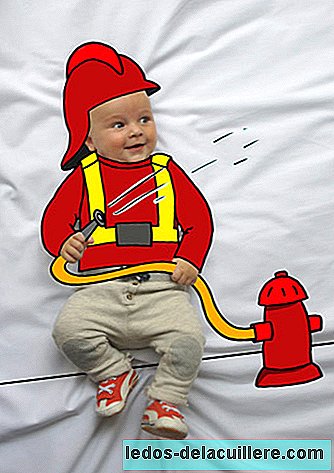
The truth is that I had never considered getting a tubal ligation due to the doubt of whether or not it was reversible. Also, since I am quite clueless for medication issues, I have never taken a contraceptive pill because I was convinced that I would forget nine times out of 10. That's how I am.
When I had my first child I decided to look for a contraceptive method of a certain duration and I opted for the IUD, despite the numerous testimonies of "because I have an acquaintance who became pregnant with him." My experience really was not very positive, but I will leave it for another post. When I learned that I was going to have twins, I knew that I would not have children anymore and that was when my gynecologist asked me if I would want to undergo a tubal ligation in case of a C-section. Great question, I had never thought about it! I had enough doubts, on the one hand I did not raise more children, but what if one day I was encouraged again? Was it reversible?
Before undergoing the operation I decided to gather all possible information and not from any source but from my trusted gynecologist whom I interviewed conscientiously to be able to make a decision with certainty. I was interested to know especially how long the process lasted, possible side effects, if it was reversible ... Below you can see all my doubts cleared.
How is the process done?
It can be done in two ways:
Tubal ligation by laparotomy: it is the most common during a C-section because the abdomen is opened where it is used to cut a piece of each tube and ligate them. Recovery will basically depend on the opening in the abdomen, in this case the caesarean section.
Tubal ligation by laparoscopy: through a small 10 mm incision. a small television camera is inserted in the navel. So on the monitor you can see the abdominal cavity inside and see the tubes and ovaries. The abdomen is inflated with gas (CO2) and when distended you can see everything without problem. In this case the tubes are removed and not linked.
Essure Method: until now it was another of the usual procedures but since August 3, 2017, the Spanish Agency for Medicines and Health Products has suspended the use of this method in Spanish hospitals. Patients have reported effects such as pelvic inflammatory disease, severe pain in the pelvic and abdominal region or tubal perforation. Other symptoms that have occurred have been cramping, bleeding and nausea, changes in the menstrual cycle or a possible allergic reaction due to implant materials, such as nickel. Even, in some cases, contraception has failed. But how was it done? It did not require surgical incision or anesthesia but it was a titanium metal microinsert that was inserted into the tube causing inflammation that eventually became a scar. This scar was the one that acted as a barrier and clogged the tube preventing pregnancy. For this method to work, at least 3 months had to pass since its placement.
How long is the procedure?
If it is performed during a C-section it takes about 10 min. more or less, depending on how accessible the tubes are. If it is performed in a non-pregnant patient, the intervention is performed laparoscopically, that is, without having to open the gut through trocars through the navel, insufflating gas to distend the abdomen and have a field of vision. This procedure is fast, it is done with sedation and it takes about 20-30 minutes; The patient can go home that same day. What is done is to remove the tubes, not to bind them, as when doing intracesarea.
In my case it was during a C-section and the truth is that the ligation and the closure of my scar was quite fast and very soon I was in a room alone with my babies and my husband recovering without problem.
Are there any side effects?
Whether a tubal ligation is done or removed (salpinguectomy) there is no side effect, since the tubes only have the task of transporting the oocyte to the uterus. The only effect it has is contraceptive.
Personally I have not noticed anything different in my period or anything similar.
As indicated by the WHO "in general, female sterilization performed using the techniques described (...) is risk-free, so there are rare cases in which complications arise." But they cite some specific ones like:
- Side effects Are those symptoms attributable to surgery but do not require exceptional measures. They include abdominal, dorsal or chest pains, nausea and vomiting.
- Complications are problems directly related to surgery or anesthesia. that ensue during the following 42 days and require more extensive measures and treatments than one would expect. They include infection, hemorrhage, accidental injury and depression of breathing or blood pressure caused by anesthesia.

What are the advantages and disadvantages?
If our goal is to have no more children, the advantage is that, contraceptive. It has no disadvantages or side effects. It does not affect the cycle or the woman's rules.
Is it reversible?
No. The reversal of the operation has very few possibilities and the solution that would succeed in reaching a pregnancy would be to resort to IVF. That is why it is important to have this decision very clear.
This part was what scared me. It was giving up being a mother again. I already have three children but I didn't know if I would like to repeat the experience and that scared me ...
At this point the WHO notes that "female sterilization should not be proposed or used as a reversible method of fertility regulation. Although it is possible to resort to reconstructive surgery operations to restore fertility and several countries have created services for this purpose, the proportion of clients who request these services and then get pregnant is very low. " So ... think about it.
Do you know any case in which the process has failed?
According to my gynecologist, throughout her professional career she has only seen one case of a woman who with a tubal ligation became pregnant.
When I signed the consent I already said it, it is not 100% effective as it happens with the rest of contraceptive methods.
In addition, he told me that tubal ligation is usually offered when the patient is going to undergo a second or third C-section and is absolutely clear that she has fulfilled her genetic desires.
Anesthesia, main handicap
Generally, the reason that patients change their mind and finally do not decide to undergo this procedure has to do with the fear of sedation, which is with local anesthesia. Specifically, salpinguectomy is a safe technique and the laparoscopic route only leaves a very small scar, so the fear of anesthesia is no reason to decide whether or not to do it. In spite of everything, there is still a lot of fear of anesthesia in our environment.
And you, have you thought about having a tubal ligation?












